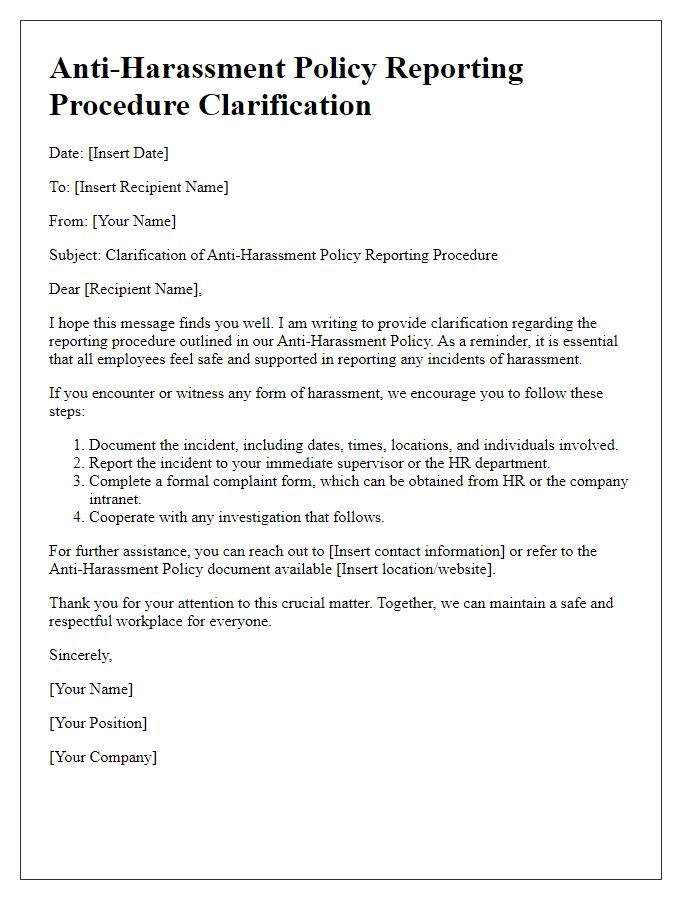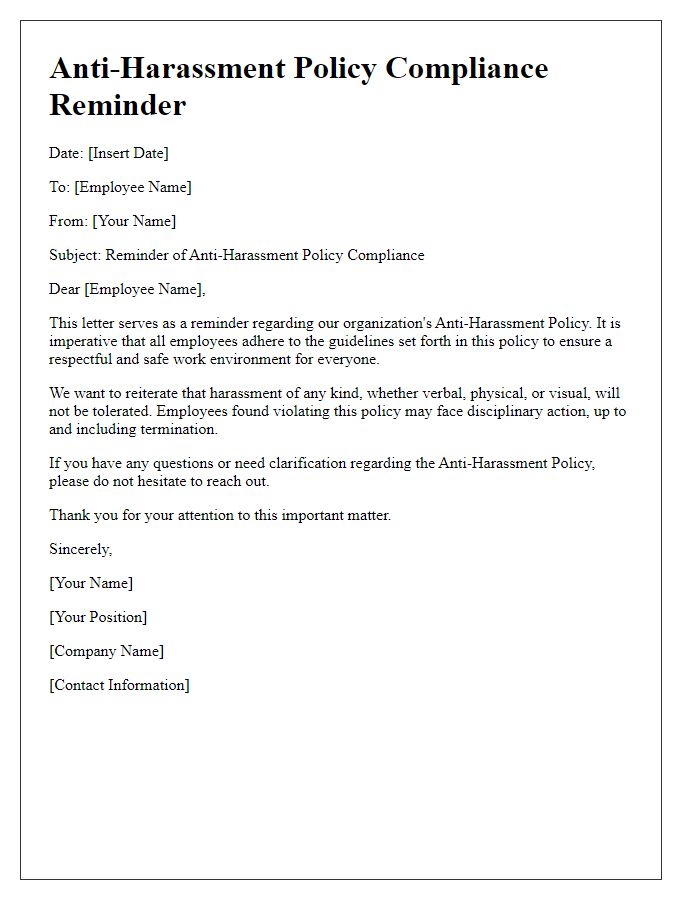In today's world, workplaces must prioritize safety and respect for all employees, making an effective anti-harassment policy crucial. This policy serves as a protective shield, ensuring that every individual can work free from fear or intimidation. Adopting and enforcing such a framework not only cultivates a positive work culture but also promotes productivity and employee morale. Curious to learn more about how to implement these policies effectively?

Clear statement of zero tolerance
The anti-harassment policy mandates a zero-tolerance approach towards all forms of harassment, including verbal, physical, and psychological abuse within the workplace environment. This policy serves to protect employees in various settings such as corporate offices, remote workspaces, and public interactions during company events. Immediate reporting procedures are established to address any incidents of harassment, ensuring swift action from human resources or designated personnel. Training sessions are scheduled bi-annually to promote awareness and understanding of acceptable behavior and potential consequences for violations. The organization strongly emphasizes the importance of employee safety, fostering a respectful and inclusive culture for all personnel. Violations can lead to disciplinary action, including termination or legal repercussions, reinforcing the commitment to a harassment-free workplace.
Definition of harassment types
Harassment in the workplace encompasses various behaviors that create a hostile or intimidating environment. Verbal harassment includes offensive remarks, jokes, or slurs based on gender, race, religion, or other protected characteristics. Physical harassment involves unwanted touching, aggressive gestures, or any form of physical intimidation. Visual harassment includes the display of inappropriate images, posters, or materials that demean or offend individuals. Cyber harassment occurs through electronic means, such as emails or social media, including threats, malicious messages, or belittling comments. Understanding these types of harassment is crucial for fostering a safe and respectful workplace, ensuring all employees can work without fear of discrimination or intimidation.
Reporting procedure and confidentiality
The reporting procedure for enforcing the anti-harassment policy is pivotal in ensuring a safe environment for all employees. Individuals subjected to harassment, including actions like unwanted advances or derogatory remarks, should report incidents immediately to the designated Human Resources department at [Company Name] located at [Office Location]. Reports can be submitted via email or through the secure online portal, ensuring confidentiality throughout the process. Employee identities will remain protected, with details only shared with those directly involved in the investigation. Timely submission increases the chance of a thorough investigation, typically conducted within [specific time frame, e.g., 14 days]. Comprehensive documentation is encouraged, including date, time, location, and specifics of the incident, to facilitate an effective process in addressing and resolving issues. Support mechanisms, such as counseling services, are available for affected individuals during and after the investigation.
Consequences and disciplinary actions
The enforcement of an anti-harassment policy is crucial for maintaining a safe and respectful environment in workplaces, schools, or any organizational setting. Consequences for violating this policy may include disciplinary actions such as written warnings, mandatory training sessions on harassment awareness, suspension for a specified duration, or termination of employment or enrollment in serious cases. The severity of actions taken often depends on factors such as the nature of the harassment, frequency of occurrences, and the impact on the victim. Processes for reporting incidents, such as designated hotlines or reporting forms, play a vital role in ensuring accountability and transparency. Furthermore, organizations may implement follow-up measures to assess the effectiveness of disciplinary actions and prevent recurrence of harassment. Each incident is thoroughly investigated, adhering to principles of fairness and confidentiality, to protect the rights of all individuals involved.
Commitment to a safe work environment
A robust anti-harassment policy is essential for maintaining a safe and respectful work environment within organizations. This policy emphasizes zero tolerance towards any form of harassment, including verbal, physical, or psychological, that may occur in locations such as offices, meeting rooms, and company events. Employees are encouraged to report incidents of harassment through designated channels, ensuring confidentiality and protection against retaliation. Training programs are scheduled regularly, enhancing awareness among staff about the importance of mutual respect and dignity. Furthermore, the policy outlines the consequences for violators, which may include disciplinary actions or termination of employment, reinforcing the commitment to uphold a safe workplace. Resources such as counseling services are also provided, highlighting the organization's dedication to employee well-being and support.
Letter Template For Anti-Harassment Policy Enforcement Samples
Letter template of anti-harassment policy reporting procedure clarification













Comments